金属基复合材料1资料
- 格式:ppt
- 大小:5.29 MB
- 文档页数:13
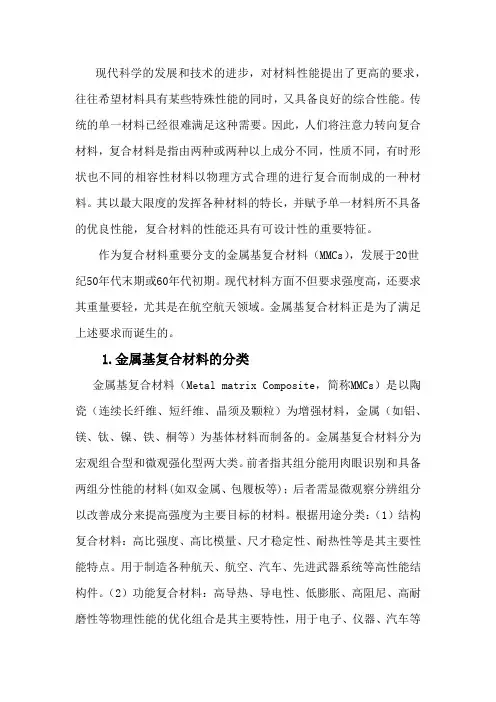
现代科学的发展和技术的进步,对材料性能提出了更高的要求,往往希望材料具有某些特殊性能的同时,又具备良好的综合性能。
传统的单一材料已经很难满足这种需要。
因此,人们将注意力转向复合材料,复合材料是指由两种或两种以上成分不同,性质不同,有时形状也不同的相容性材料以物理方式合理的进行复合而制成的一种材料。
其以最大限度的发挥各种材料的特长,并赋予单一材料所不具备的优良性能,复合材料的性能还具有可设计性的重要特征。
作为复合材料重要分支的金属基复合材料(MMCs),发展于20世纪50年代末期或60年代初期。
现代材料方面不但要求强度高,还要求其重量要轻,尤其是在航空航天领域。
金属基复合材料正是为了满足上述要求而诞生的。
1.金属基复合材料的分类金属基复合材料(Metal matrix Composite,简称MMCs)是以陶瓷(连续长纤维、短纤维、晶须及颗粒)为增强材料,金属(如铝、镁、钛、镍、铁、桐等)为基体材料而制备的。
金属基复合材料分为宏观组合型和微观强化型两大类。
前者指其组分能用肉眼识别和具备两组分性能的材料(如双金属、包履板等);后者需显微观察分辨组分以改善成分来提高强度为主要目标的材料。
根据用途分类:(1)结构复合材料:高比强度、高比模量、尺才稳定性、耐热性等是其主要性能特点。
用于制造各种航天、航空、汽车、先进武器系统等高性能结构件。
(2)功能复合材料:高导热、导电性、低膨胀、高阻尼、高耐磨性等物理性能的优化组合是其主要特性,用于电子、仪器、汽车等工业。
强调具有电、热、磁等功能特性。
(3)智能复合材料:强调具有感觉、反应、自监测、自修复等特性。
根据复合材料基体可划分为铝基、镁基、钢基、钛基、高温合金基、金属间化合物基及耐热金属基复合材料等。
按按增强体分类划分为颗粒增强金属基复合材料、层状增强金属基复合材料和纤维增强金属基复合材料。
2.金属基复合材料的性能特点与传统的金属材料相比,金属基复合材料具有较高的比强度与比刚度,而与高分子基复合材料相比,它又具有优良的导电性而耐热性,与陶瓷材料相比,它又具有较高的韧性和较高的抗冲击性能。
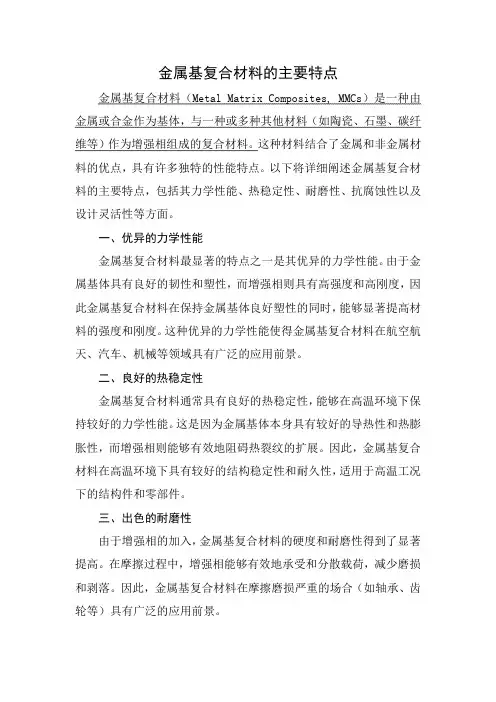
金属基复合材料的主要特点金属基复合材料(Metal Matrix Composites, MMCs)是一种由金属或合金作为基体,与一种或多种其他材料(如陶瓷、石墨、碳纤维等)作为增强相组成的复合材料。
这种材料结合了金属和非金属材料的优点,具有许多独特的性能特点。
以下将详细阐述金属基复合材料的主要特点,包括其力学性能、热稳定性、耐磨性、抗腐蚀性以及设计灵活性等方面。
一、优异的力学性能金属基复合材料最显著的特点之一是其优异的力学性能。
由于金属基体具有良好的韧性和塑性,而增强相则具有高强度和高刚度,因此金属基复合材料在保持金属基体良好塑性的同时,能够显著提高材料的强度和刚度。
这种优异的力学性能使得金属基复合材料在航空航天、汽车、机械等领域具有广泛的应用前景。
二、良好的热稳定性金属基复合材料通常具有良好的热稳定性,能够在高温环境下保持较好的力学性能。
这是因为金属基体本身具有较好的导热性和热膨胀性,而增强相则能够有效地阻碍热裂纹的扩展。
因此,金属基复合材料在高温环境下具有较好的结构稳定性和耐久性,适用于高温工况下的结构件和零部件。
三、出色的耐磨性由于增强相的加入,金属基复合材料的硬度和耐磨性得到了显著提高。
在摩擦过程中,增强相能够有效地承受和分散载荷,减少磨损和剥落。
因此,金属基复合材料在摩擦磨损严重的场合(如轴承、齿轮等)具有广泛的应用前景。
四、优异的抗腐蚀性金属基复合材料中的增强相通常具有较好的化学稳定性,能够有效地提高材料的抗腐蚀性能。
此外,通过合理的成分设计和表面处理,还可以进一步提高金属基复合材料的耐腐蚀性能。
这使得金属基复合材料在化工、海洋等腐蚀环境中具有广阔的应用前景。
五、设计灵活性高金属基复合材料的设计灵活性较高,可以通过调整基体和增强相的成分、含量和分布来实现对材料性能的定制和优化。
例如,通过改变增强相的种类、形状和取向,可以调整材料的强度和刚度;通过调整基体的成分和处理工艺,可以改善材料的塑性和韧性。
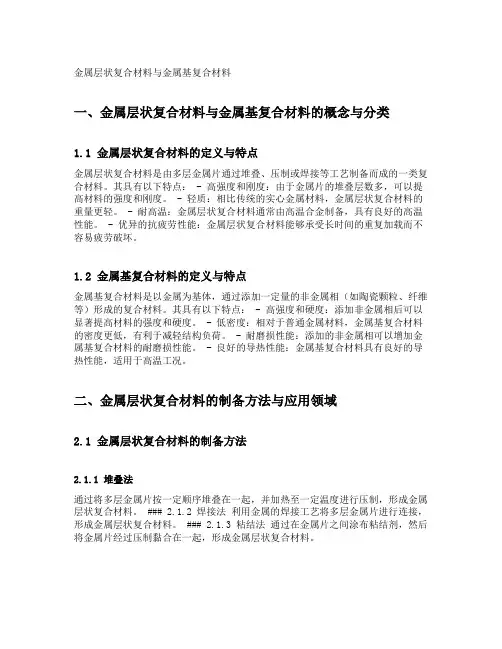
金属层状复合材料与金属基复合材料一、金属层状复合材料与金属基复合材料的概念与分类1.1 金属层状复合材料的定义与特点金属层状复合材料是由多层金属片通过堆叠、压制或焊接等工艺制备而成的一类复合材料。
其具有以下特点: - 高强度和刚度:由于金属片的堆叠层数多,可以提高材料的强度和刚度。
- 轻质:相比传统的实心金属材料,金属层状复合材料的重量更轻。
- 耐高温:金属层状复合材料通常由高温合金制备,具有良好的高温性能。
- 优异的抗疲劳性能:金属层状复合材料能够承受长时间的重复加载而不容易疲劳破坏。
1.2 金属基复合材料的定义与特点金属基复合材料是以金属为基体,通过添加一定量的非金属相(如陶瓷颗粒、纤维等)形成的复合材料。
其具有以下特点: - 高强度和硬度:添加非金属相后可以显著提高材料的强度和硬度。
- 低密度:相对于普通金属材料,金属基复合材料的密度更低,有利于减轻结构负荷。
- 耐磨损性能:添加的非金属相可以增加金属基复合材料的耐磨损性能。
- 良好的导热性能:金属基复合材料具有良好的导热性能,适用于高温工况。
二、金属层状复合材料的制备方法与应用领域2.1 金属层状复合材料的制备方法2.1.1 堆叠法通过将多层金属片按一定顺序堆叠在一起,并加热至一定温度进行压制,形成金属层状复合材料。
### 2.1.2 焊接法利用金属的焊接工艺将多层金属片进行连接,形成金属层状复合材料。
### 2.1.3 粘结法通过在金属片之间涂布粘结剂,然后将金属片经过压制黏合在一起,形成金属层状复合材料。
2.2 金属层状复合材料的应用领域•航空航天领域:金属层状复合材料具有优异的强度和轻质特性,适用于航空航天结构件的制造,如飞机机身、发动机部件等。
•汽车领域:金属层状复合材料可以用于制造汽车车身结构,降低整车的重量,提高燃油经济性。
•建筑领域:金属层状复合材料的高强度和刚度特性,使其成为建筑结构中的重要材料,如大跨度屋顶、桥梁等。
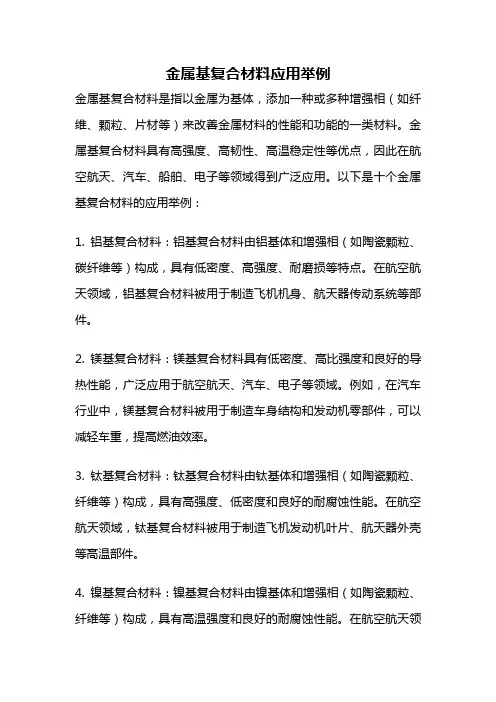
金属基复合材料应用举例金属基复合材料是指以金属为基体,添加一种或多种增强相(如纤维、颗粒、片材等)来改善金属材料的性能和功能的一类材料。
金属基复合材料具有高强度、高韧性、高温稳定性等优点,因此在航空航天、汽车、船舶、电子等领域得到广泛应用。
以下是十个金属基复合材料的应用举例:1. 铝基复合材料:铝基复合材料由铝基体和增强相(如陶瓷颗粒、碳纤维等)构成,具有低密度、高强度、耐磨损等特点。
在航空航天领域,铝基复合材料被用于制造飞机机身、航天器传动系统等部件。
2. 镁基复合材料:镁基复合材料具有低密度、高比强度和良好的导热性能,广泛应用于航空航天、汽车、电子等领域。
例如,在汽车行业中,镁基复合材料被用于制造车身结构和发动机零部件,可以减轻车重,提高燃油效率。
3. 钛基复合材料:钛基复合材料由钛基体和增强相(如陶瓷颗粒、纤维等)构成,具有高强度、低密度和良好的耐腐蚀性能。
在航空航天领域,钛基复合材料被用于制造飞机发动机叶片、航天器外壳等高温部件。
4. 镍基复合材料:镍基复合材料由镍基体和增强相(如陶瓷颗粒、纤维等)构成,具有高温强度和良好的耐腐蚀性能。
在航空航天领域,镍基复合材料被用于制造航空发动机涡轮叶片、燃烧室等高温部件。
5. 铜基复合材料:铜基复合材料由铜基体和增强相(如碳纤维、陶瓷颗粒等)构成,具有高导电性和高热导率。
在电子领域,铜基复合材料被用于制造高性能散热器、电子封装材料等。
6. 钨基复合材料:钨基复合材料由钨基体和增强相(如碳纤维、陶瓷颗粒等)构成,具有高密度、高熔点和高强度。
在核工业领域,钨基复合材料被用于制造核反应堆材料、高温组件等。
7. 铁基复合材料:铁基复合材料由铁基体和增强相(如碳纤维、陶瓷颗粒等)构成,具有高强度和良好的耐磨性。
在机械制造领域,铁基复合材料被用于制造高性能齿轮、轴承等零部件。
8. 锆基复合材料:锆基复合材料由锆基体和增强相(如陶瓷颗粒、纤维等)构成,具有高温稳定性和良好的耐腐蚀性能。




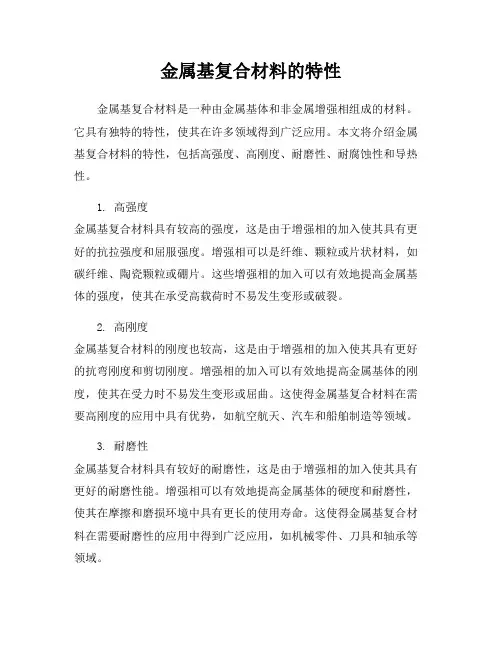
金属基复合材料的特性金属基复合材料是一种由金属基体和非金属增强相组成的材料。
它具有独特的特性,使其在许多领域得到广泛应用。
本文将介绍金属基复合材料的特性,包括高强度、高刚度、耐磨性、耐腐蚀性和导热性。
1. 高强度金属基复合材料具有较高的强度,这是由于增强相的加入使其具有更好的抗拉强度和屈服强度。
增强相可以是纤维、颗粒或片状材料,如碳纤维、陶瓷颗粒或硼片。
这些增强相的加入可以有效地提高金属基体的强度,使其在承受高载荷时不易发生变形或破裂。
2. 高刚度金属基复合材料的刚度也较高,这是由于增强相的加入使其具有更好的抗弯刚度和剪切刚度。
增强相的加入可以有效地提高金属基体的刚度,使其在受力时不易发生变形或屈曲。
这使得金属基复合材料在需要高刚度的应用中具有优势,如航空航天、汽车和船舶制造等领域。
3. 耐磨性金属基复合材料具有较好的耐磨性,这是由于增强相的加入使其具有更好的耐磨性能。
增强相可以有效地提高金属基体的硬度和耐磨性,使其在摩擦和磨损环境中具有更长的使用寿命。
这使得金属基复合材料在需要耐磨性的应用中得到广泛应用,如机械零件、刀具和轴承等领域。
4. 耐腐蚀性金属基复合材料具有较好的耐腐蚀性,这是由于增强相的加入使其具有更好的耐腐蚀性能。
增强相可以有效地提高金属基体的抗腐蚀能力,使其在腐蚀介质中具有更长的使用寿命。
这使得金属基复合材料在需要耐腐蚀性的应用中得到广泛应用,如化工设备、海洋工程和石油钻探等领域。
5. 导热性金属基复合材料具有较好的导热性,这是由于金属基体的导热性能较好。
金属基体可以有效地传导热量,使其在需要导热性的应用中具有优势,如散热器、电子器件和航空发动机等领域。
综上所述,金属基复合材料具有高强度、高刚度、耐磨性、耐腐蚀性和导热性等特性。
这些特性使得金属基复合材料在许多领域得到广泛应用,如航空航天、汽车、机械制造和化工等领域。
随着科技的不断进步,金属基复合材料的特性将得到进一步的提升和应用拓展。
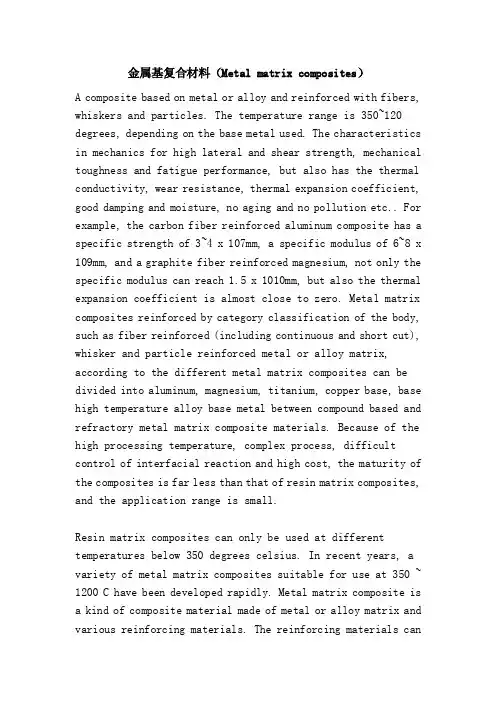
金属基复合材料(Metal matrix composites)A composite based on metal or alloy and reinforced with fibers, whiskers and particles. The temperature range is 350~120 degrees, depending on the base metal used. The characteristics in mechanics for high lateral and shear strength, mechanical toughness and fatigue performance, but also has the thermal conductivity, wear resistance, thermal expansion coefficient, good damping and moisture, no aging and no pollution etc.. For example, the carbon fiber reinforced aluminum composite has a specific strength of 3~4 x 107mm, a specific modulus of 6~8 x 109mm, and a graphite fiber reinforced magnesium, not only the specific modulus can reach 1.5 x 1010mm, but also the thermal expansion coefficient is almost close to zero. Metal matrix composites reinforced by category classification of the body, such as fiber reinforced (including continuous and short cut), whisker and particle reinforced metal or alloy matrix, according to the different metal matrix composites can be divided into aluminum, magnesium, titanium, copper base, base high temperature alloy base metal between compound based and refractory metal matrix composite materials. Because of the high processing temperature, complex process, difficult control of interfacial reaction and high cost, the maturity of the composites is far less than that of resin matrix composites, and the application range is small.Resin matrix composites can only be used at different temperatures below 350 degrees celsius. In recent years, a variety of metal matrix composites suitable for use at 350 ~ 1200 C have been developed rapidly. Metal matrix composite is a kind of composite material made of metal or alloy matrix and various reinforcing materials. The reinforcing materials canbe fibrous, granular and whisker like silicon carbide, boron, alumina and carbon fiber. In addition to metal aluminum and magnesium, metal matrix also develops non-ferrous metals such as titanium, copper, zinc, lead, beryllium, super alloy and intermetallic compound, and ferrous metal as metal matrix. In addition to the high strength and high modulus of resin matrix composites, metal matrix composites can resist high temperature, non burning, non moisture absorption, good thermal conductivity and radiation resistance. High temperature materials for impressiveness aerospace, surface material can be used as aircraft turbine engine and rocket engine hot and supersonic aircraft. At present, the development and perfection of metal matrix composites is the fastest development of SiC particle aluminum alloy. The proportion of the metal matrix composite is only 1/3 of the steel, 2/3 of the titanium alloy, similar to that of the aluminum alloy. Its strength is better than that of medium carbon steel, similar to titanium alloy but slightly higher than that of aluminum alloy. The wear resistance of the alloy is better than that of the titanium alloy and aluminum alloy. It has been used in automobile industry and machinery industry in small quantities. In 5~15 years of commercial applications are automobile parts, brake piston, connecting rod, robot parts, computer parts, sports equipment, etc.. The main problem of metal matrix composites is that the manufacturing process of metal composite is complex and expensive, and it can not be used in industrial scale production.Composite plate: refers to a metal plate on the cover of another metal plate, in order to achieve the effect of not reducing the use (corrosion resistance, mechanical strength, etc.) underthe premise of saving resources and reducing costs. Composite methods usually include explosive bonding, explosive rolling and rolling bonding. Composite materials can be divided into composite plate, composite pipe, composite rod and so on. Mainly used in anti-corrosion, pressure vessel manufacturing, electric power construction, petrochemical, pharmaceutical, light industry, automobile and other industries.Stainless steel clad plate is a composite plate steel made of carbon steel base and stainless steel cladding. Its main feature is the formation of a strong metallurgical bond between carbon steel and stainless steel. It can be processed by hot pressing, cold bending, cutting, welding and so on, and has good technological properties. The base material of stainless steel clad plate can be made of ordinary carbon steel and special steel, such as Q235B, 16MnR, 20R, etc.. Cladding materials can be made of stainless steels of various grades such as 304, 316L, 1Cr13 and duplex stainless steel. Material and thickness can be freely assembled to meet the needs of different users. Stainless steel clad plate has been widely used in petroleum, chemical industry, salt industry, water conservancy and electric power industry. As a resource saving product, the stainless steel clad plate can reduce the consumption of precious metal,Greatly reduce the project cost. Realize the perfect combination of low cost and high performance, and have good social benefits.Stainless steel clad plate is how to produce it? There are two methods for industrial production of stainless steel clad plate,explosive cladding and hot rolling. The production process of the explosive clad plate is that the stainless steel plate is overlapped on the carbon steel substrate, and the stainless steel plate and the carbon steel plate are separated by a cushion. The stainless steel plate is covered with explosive and explosive energy, which makes the stainless steel plate impact on the carbon steel substrate at high speed and produce high temperature and high pressure to realize the solid phase welding of the interface between the two materials. Ideally, the shear strength of the interface can reach 400 MPa per square millimeter. The hot rolling composite plate process is made of carbon steel substrate and stainless steel plate in the state of physical purity and rolled under high vacuum condition. In the process of rolling, two kinds of metal diffusion achieve complete metallurgical bonding. Of course, in order to improve the wettability of composite interface and improve the bonding strength, a series of technical measures should be taken in the physical and chemical treatment of the interface. The above two kinds of composite plate manufacturing methods are carried out GB/T-8165-1977 national standards. This standard is not equivalent to or higher than the same JISG36011990 Japanese standard, Japanese standard main technical indicators.How about the process characteristics of the blast clad and hot rolled composite plate? First, the explosive composite features: first, because the explosion is cold processing, so it can produce in addition to stainless steel composite plate, many kinds of metal composite plate, such as titanium, copper, aluminum and so on. Two, explosive composite can produce stainless steel composite plate, the total thickness can reach hundreds of millimeters thick stainless steel composite plate,such as some large base and tube plate, etc.. But it is not suitable for producing thinner composite steel plate with total thickness less than 10 mm. Three explosive composite use of explosive energy production, the environment will cause vibration, noise and soot pollution. However, the equipment investment is small, and there are hundreds of domestic explosive production plants. Due to the restrictions of weather and other process conditions, the explosive composite production efficiency is low. Besides, the characteristics of hot rolling compound technology are as follows: 1. Large medium plate mill and hot strip mill are used, so the production efficiency is high and the supply speed is fast. The product is large in size and free in thickness. Stainless steel coating thickness above 0.5mm can be produced. But the investment is large, so the manufacturers are less. Two, due to the limitation of steel rolling compression ratio, hot rolling production can not produce composite steel plate with thickness of more than 50mm, and it is not convenient to produce various small, round and other special shaped composite plate. Advantages of hot rolled composite plates of 6, 8 and 10 mm for thin gauge composite plates. Under the condition of hot continuous rolling, the composite bending plate can be produced, the production cost can be reduced, and more users' demands can be met. Three, in the current technical conditions, hot rolling process can not directly produce titanium, copper, aluminum and other non-ferrous metal composite plate. To sum up, the two different production processes have their own characteristics, exist and develop at the same time, to meet the diverse needs of different users. Explosive rolling is the combination of the two processes mentioned above, no more details.Stainless steel composite plate has the characteristics of various carbon steel and stainless steel, with its excellent performance price ratio for users, and has broad market prospects. But interestingly, from the beginning of 50s, after more than half a century of ups and downs of the development process, there are still many people do not know it. More people haven't used it. It should be said that the stainless steel composite plate market is far from mature, and still in the process of development. The exploration and efforts of scientific and technical workers to build a resource conserving society will never cease.Composite materials (Composite) is a kind of material which is made of one material as the matrix (Matrix) and the other as the reinforcing body (reinforcement). Various materials can complement each other in performance and produce synergistic effect, so that the comprehensive properties of composite materials are better than those of the original materials and meet various requirements. The matrix materials of composite materials are divided into two categories: metal and nonmetal. Aluminum, magnesium, copper, titanium and their alloys are commonly used in metal matrix.The non-metallic matrix mainly includes synthetic resin, rubber, ceramic, graphite, carbon and so on. The reinforcing materials mainly include glass fiber, carbon fiber, boron fiber, aramid fiber, silicon carbide fiber, asbestos fiber, whisker, wire and hard fine particles, etc..The history of composite materials can be traced back to ancient times. Since ancient times, the use of straw reinforced clayand reinforced concrete has been used for two centuries. In 1940s, due to the needs of the aviation industry, glass fiber reinforced plastics (commonly known as glass fiber reinforced plastics) were developed, and the name of composite material emerged. Since 50s, high strength and high modulus fibers such as carbon fiber, graphite fiber and boron fiber have been developed. Aramid fiber and silicon carbide fiber appeared in 70s. These high strength and high modulus fibers can be compounded with non metallic matrix such as synthetic resin, carbon, graphite, ceramic, rubber and other metal matrix, such as aluminum, magnesium, titanium, and so on, and form composite materials with different characteristics.The forming methods of composites are different according to the matrix materials. More molding method of resin matrix composites, a hand lay up molding injection molding, filament winding, molding, pultrusion, autoclave molding, molding, transfer molding, diaphragm reaction injection molding, molding, stamping and other soft expansion. The forming methods of metal matrix composites are divided into solid phase forming method and liquid phase forming method. The former is formed by applying pressure at lower than the melting point temperature of the matrix, including diffusion welding, powder metallurgy, hot rolling, hot drawing, hot isostatic pressing and explosive welding. The latter is the substrate melting, filling the reinforcement materials, including traditional casting, vacuum casting, vacuum counter pressure casting, extrusion casting and spray casting and forming method of ceramic matrix composite materials are mainly solid phase sintering, chemical vapor infiltration molding, molding and other chemical vapor deposition.The main application fields of composite materials are:Aerospace field. The composite material has good thermal stability, high specific strength and stiffness, can be used in the manufacture of aircraft wing and fuselage, satellite antenna and its supporting structure, solar wing and shell, large rocket engine shell, shell, space shuttle structure etc..Automobile industry. The composite material has the special characteristics of vibration damping, vibration damping and noise reduction, anti fatigue performance is good, easy to repair after injury, to facilitate the overall shape, it can be used in the manufacture of automobile, mechanical components, transmission shaft, engine frame and internal components.Chemical, textile and mechanical manufacturing. The material with good corrosion resistance of carbon fiber and resin matrix can be used for manufacturing chemical equipment, textile machines, paper machines, copiers, high-speed machine tools, precision instruments, etc..Medical field. Carbon fiber composite has excellent mechanical properties and does not absorb X ray characteristics. It can be used in the manufacture of medical X ray machine and orthopedic stent. Carbon fiber composites also have biological compatibility and blood compatibility, and have good stability in biological environment, and they are also used as biomedical materials. In addition, composites are also used to make sports devices and use as building materials.Metal matrix compositesMetal and ceramic composite material, belongs to particle reinforced composite material, also known as metal ceramicCemented carbideProperties and applications: high hardness, high wear resistance, high red hardness, high thermal stability and oxidation resistanceIt is suitable for all kinds of high speed cutting tools, wear parts at various high temperature, such as hot drawing die, etc.1. tungsten cobalt carbide - pressed and sintered from cobalt Co and tungsten carbide WCGrade: the content of YG+Co, such as YG3, YG6, YG8.Co, the higher the content, the better the toughnessPerformance characteristics - high hardness, high wear resistance, high red hardness, good toughnessPurpose: to make cutting tools for brittle materials such as cast iron, non-ferrous metals and non-metallic materials, such as: YG8 tools are suitable for rough cast iron, YG3 is suitable for finishing cast iron, YG6 is suitable for semi finishing cast iron2. tungsten titanium cobalt carbide - pressed and sintered from cobalt Co and tungsten carbide WC+TiCBrand: the percentage content of YT+TiC, such as YT5, YT15 and YYT30.TiC, is higher,The toughness is betterPerformance characteristics hardness and red hardness are higher than class YG, toughness, strength is slightly lower than class YGUse - cutting tools for making all kinds of steel, such as: YT5 tools suitable for rough machining steel, YT15 suitable for finishing steel, YT suitable for semi finishing steel3. tungsten titanium tantalum cobalt hard alloy - pressed and sintered from cobalt Co+WC+TiC+TaCBrands: YW, such as YW1 and YW2Performance characteristics - both YG, YT advantages, also known as general-purpose cemented carbide and universal cemented carbideApplication: cutting tools for refractory materials such as heat resistant steel and alloy。

⾦属基复合材料以⾦属或合⾦为基体,并以纤维、晶须、颗粒等为增强体的复合材料。
按所⽤的基体⾦属的不同,使⽤温度范围为350~120℃。
其特点在⼒学⽅⾯为横向及剪切强度较⾼,韧性及疲劳等综合⼒学性能较好,同时还具有导热、导电、耐磨、热膨胀系数⼩、阻尼性好、不吸湿、不⽼化和⽆污染等优点。
例如碳纤维增强铝复合材料其⽐强度3~4×107mm,⽐模量为6~8×109mm,⼜如⽯墨纤维增强镁不仅⽐模量可达1.5×1010mm,⽽且其热膨胀系数⼏乎接近零。
⾦属基复合材料按增强体的类别来分类,如纤维增强(包括连续和短切)、晶须增强和颗粒增强等,按⾦属或合⾦基体的不同,⾦属基复合材料可分为铝基、镁基、铜基、钛基、⾼温合⾦基、⾦属间化合物基以及难熔⾦属基复合材料等。
由于这类复合材料加⼯温度⾼、⼯艺复杂、界⾯反应控制困难、成本相对⾼,应⽤的成熟程度远不如树脂基复合材料,应⽤范围较⼩。
树脂基复合材料通常只能在350℃以下的不同温度范围内使⽤。
近些年来正在迅速开发研究适⽤于350℃~1200℃使⽤的各种⾦属基复合材料。
⾦属基复合材料是以⾦属或合⾦为基体与各种增强材料复合⽽制得的复合材料。
增强材料可为纤维状、颗粒状和晶须状的碳化硅、硼、氧化铝及碳纤维。
⾦属基体除⾦属铝、镁外,还发展有⾊⾦属钛、铜、锌、铅、铍超合⾦和⾦属间化合物,及⿊⾊⾦属作为⾦属基体。
⾦属基复合材料除了和树脂基复合材料同样具有⾼强度、⾼模量外,它能耐⾼温,同时不燃、不吸潮、导热导电性好、抗辐射。
是令⼈注⽬的航空航天⽤⾼温材料,可⽤作飞机涡轮发动机和⽕箭发动机热区和超⾳速飞机的表⾯材料。
⽬前不断发展和完善的⾦属基复合材料以碳化硅颗粒铝合⾦发展最快。
这种⾦属基复合材料的⽐重只有钢的1/3,为钛合⾦的2/3,与铝合⾦相近。
它的强度⽐中碳钢好,与钛合⾦相近⽽⼜⽐铝合⾦略⾼。
其耐磨性也⽐钛合⾦、铝合⾦好。
⽬前已⼩批量应⽤于汽车⼯业和机械⼯业。